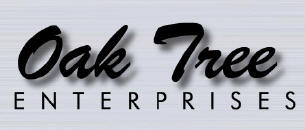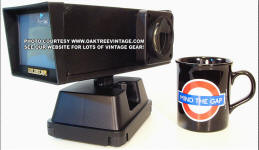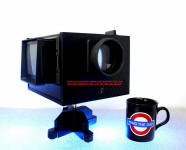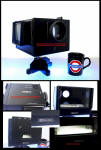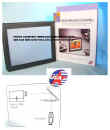Notes on Film
Projectors:
Auto-Load: While "Auto-Load" can work to varying degrees on
different film projectors models, it is notorious for eating films. The
overall design went through an evolution over the years, but even the best
designs will eat films on occasion. This is usually due to poorly trimmed
film, excessive curling of film (usually associated with smaller reel
diameters), bent / crumpled leader ends. An excessively "curled" film can be
almost impossible to "auto-load". Film eating can also be due to projector
maintenance issues.
Projector Chatter: A well maintained and properly adjusted
projector should not "chatter" when projecting film with good condition /
clean sprocket holes and properly done splices. However, even the best
projectors will chatter when trying to project film with torn, worn, missing
and otherwise imperfect sprocket holes and bad splices.
Film breakage: Other than "Auto-Load" / Loading issues, most
film breakage is caused not from the actual film breaking, but from previous
splices breaking. Most any film over 50 feet will contain splices and some
that are shorter will as well. If you are going to be running film through a
projector, you WILL want need to have a splice block and FRESH splice tape
for your format(s) of film handy. You WILL break film. Not much is more
frustrating than to have a broken film in the middle of a project with half
of it residing on the take-up reel and the other half still on the "feed"
reel and no way to repair or make the splice.
Flicker-Free / Flicker-Reduction: Flicker is usually an
issue when doing film to video transfers. It manifests itself by an image
that varies in degrees of brightness, similar to watching some of the early
1900 silent films. It happens due to the film shutter and the video camera
shutter, being "out of sync".
Typically silent film is shot at 18fps (frames per second), and sound film
at 24fps. Video operates at 30fps. "fps" refers to how many times per second
an image is projected or picked up. Even if both were the same fps, they
would not be in sync, without a lot of very sophisticated equipment that is
beyond the scope of most users means. There are a number of "work-arounds"
to reduce or eliminate flicker. The first, and best is to use a 5-bladed
shutter model projector. Some projectors can be retrofitted with a 5-blade
shutter or may have come originally with one. These can be relatively
expensive. The flicker is eliminated by projecting more images than is
necessary for the video camera to pickup, thus there is always a projected
image regardless of whether the video camera shutter is open or closed.
The next way is to use a "semi-pro" or professional video camera that has an
"infinitely variable" speed shutter. As of this writing, the low end of
those cost $2000 and can go up to around $5000 before reaching "pro" status.
Flicker can be reduced or eliminated in some cases, by "riding" the camera
speed control, while monitoring the video signal on a monitor (the control
needs to be infinitely variable. Having 2 or 3 different speed choices is
not sufficient).
The easiest and typically least expensive way to reduce or sometimes
eliminate flicker is to vary the speed of the projector. Many film
projectors came with a "variable speed" (needs to be an "infinitely
variable" type and not just a choice between 2 or 3 speeds) control from the
factory. If not, some lend themselves to being modified by a qualified
technician by having one added. Another possible way to achieve variable
speed on a projector that doesn't have one is to control it externally,
using a device such as a "vari-AC" (have a qualified technician determine if
your projector is a candidate for use with a vari-AC and know it's
limitations and methods for safe use. If a variable speed projector is used,
again simply "ride" the speed control while monitoring the image on the
video monitor, as you would with a variable speed camera. Flicker cannot always be eliminated, but can usually be reduced to an undetectable
degree.
Lamps / Bulbs: Due to the intensity required to project a
small image from film, through a small hole, only part of each second, some
times distances of 40 feet, projection lamps must be very powerful. This
power comes at the price of short life. Most projector lamps have life spans
of 10-50 hours and are very fragile thus, should be handled carefully.
Noise: Film projectors are very complicated mechanical things,
with lots of moving and integrated parts. There will always be a degree of
mechanical noise made by any film projector. It will very in degree by
model. Some will be relatively quiet and some will seem quite noisy.
Silent / Sound switch: This is more of an issue with 16mm Film
projectors, but the "Silent / Sound" / "Speed" mechanical switch should
never be manipulated with the projector is not running. To do so in most
cases, will require the projector be partially disassembled to re-seat the
drive belt. Again, this is usually not a problem with 8mm units or units
that make the change electronically.
Sound quality: "Consumer" film in either 8 or 16mm formats had
varying degrees of sound quality. There were many factors that could and can
effect sound quality. One is the accuracy of the camera that shot the film
originally. If it's speed was not correct or constant, that sound will be
imprinted on the film and will play back no better. Sound can vary from
usable to laughable in quality, so don't expect Hi-Fi quality by any stretch
of the imagination.
Still Function: In order to do "Still" image projection the
film must stop. In doing this, most projectors will engage a lamp filter to
reduce the amount of light, thus heat hitting a single frame of film. Also,
since projection principle incorporates rotating "blades" that alternatively
block light, there is no guarantee that when you stop forward motion, you
will be on a blade opening, thus light may be partially or completely
blocked. This will result in a partial or no image. It sometimes takes 2 to
a dozen tries to get the "sync" correct, so you see a complete image.
Further since there is a filter or light block used in "still" mode, the
brightness of the image will be reduced. Note; due to the tremendous amount
of heat produced by most projection lamps, a projector should not be left in
"still" mode for more than a few seconds. Longer may result in warped,
melted or severed film and a mess to clean up in side the projector film
gate.
Zoom Lens: Zoom actuation will vary on different projector
models. Some lenses actually have to be physically pulled or pushed to zoom.
Foot note: Film projectors are very complicated, electro-mechanical
devices. There are many sub-assemblies and systems within each, and all must
be working well together for the unit to function with any accuracy and
dependability and not "eat", damage or destroy your precious films and
movies. The moving parts always rely on lubricants to function properly and
there are commonly a few rubber parts / components as well. Most projectors
you see available today, were originally sold from the 1950's through the
early 1980's. Thus at best a projector is probably at least 25 years old.
Most are 30-40 years old. Interesting things happen to 30+ year old
lubricants and rubber parts. Lubricants actually coagulate and will cause
"close tolerance" parts to seize or freeze up. Rubber parts can become
brittle and cracked, only to break when the unit is started up. The rubber
can also revert back towards it's natural state and become a gooey tar.
Virtually every used projector out there will need and require 4-18 hours of
technician time to be brought to a "usable" state. Simply "turning one on
and getting some things to spin with no smoke coming out" is not a revealing
test, nor a basis for making a decision to purchase. Our typical customer
has previously purchased 3-5 units from individual (auction) sellers, who all stated
such things as, "we turned the unit on and it works fine", or "we ran a reel
of film through it and it worked great", or "never used, still in box"
(those are usually the worst condition and the most difficult to breath life
back into), or my personal favorite, "no way to test, but projector looks
like it should run great!" Needless to say, none of those statements
typically held true. It's not that people are trying to "rip anyone off"
(I'm a believer that YOU are 'generally' the person that allows yourself to
get "ripped off"), it's just that most non-professional sellers of film
projectors, stereo gear, guitars, microphones, keyboards or any other
technically minded items should find other things to try and sell, such as
old doilies and used baby booties. Heck, if I had an electron-microscope, a
race horse, or an F-15 fighter jet, to sell, I would be the last person you
would want to talk to about their "real" condition. All I would be able to
say is, "it looks like an F-15, doesn't have any rust, and the tires are
holding air. It must be ready to fly, right...!???"
